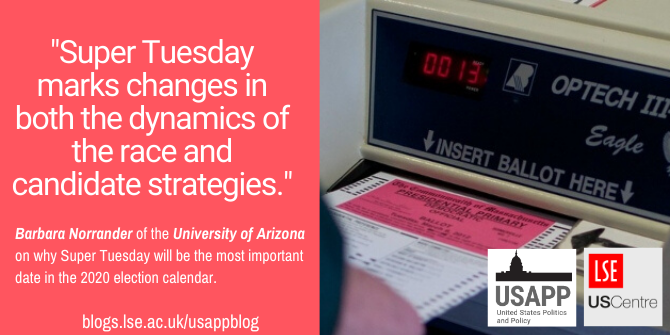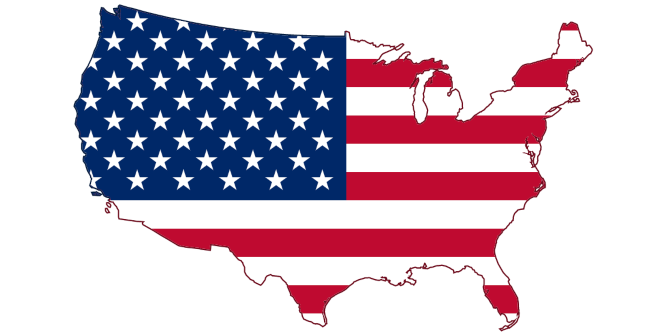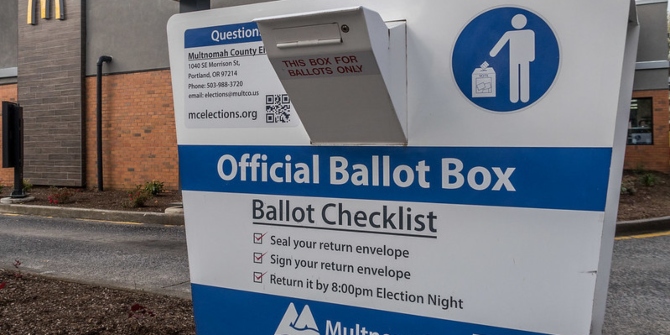 On March 3rd, 2020, 14 states will hold primary elections to determine their preferred presidential candidates. Barbara Norrander writes that these contests – which will select 34 percent of the Democrats’ convention delegates – will be the one of the most important days of the primary election calendar, and may mark the beginning of the end of the 2020 nomination fight.
On March 3rd, 2020, 14 states will hold primary elections to determine their preferred presidential candidates. Barbara Norrander writes that these contests – which will select 34 percent of the Democrats’ convention delegates – will be the one of the most important days of the primary election calendar, and may mark the beginning of the end of the 2020 nomination fight.
- This article is part of our Primary Primers series curated by Rob Ledger (Frankfurt Goethe University) and Peter Finn (Kingston University). Ahead of the 2020 election, this series explores key themes, ideas, concepts, procedures and events that shape, affect and define the US presidential primary process. If you are interested in contributing to the series contact Rob Ledger (ledger@em.uni-frankfurt.de) or Peter Finn (p.finn@kingston.ac.uk).
- On Wednesday the 4th of March 2020, as part of the LSE Festival, the US Centre will be hosting the event, Shaping America’s Future, where a panel of experts will reflect on the Super Tuesday results and make predictions for the 2020 general election.
Super Tuesday 2020 falls on March 3rd. It is a Super Tuesday because 14 states will hold their Democratic presidential primaries on that date. These states will be joined by a caucus held in American Samoa, as both political parties allow residents of US territories to participate. Together these 15 nominating events will select 1,345 delegates, 34 percent of all Democratic convention delegates selected on the basis of votes in primaries and caucuses.
In contrast to the large number of delegates selected on Super Tuesday, the first four states (Iowa, New Hampshire, Nevada and South Carolina) select only 155 delegates for 4 percent of the total. Other dates in 2020 have multiple states holding presidential primaries or caucuses, but none are as large as the first Super Tuesday. For example, the second largest single-day delegate total occurs on April 28, when 17 percent of delegates will be selected. Super Tuesday’s delegate total dwarfs those of both the front-four events and the second-largest single-day total.
A Front-loaded Primary Calendar
Super Tuesdays occur because of the nature of the modern presidential primary calendar. Tradition dictates that New Hampshire and Iowa go first. The national Democratic Party in 2008 added Nevada and South Carolina to the early schedule to incorporate their more racially and ethnically diverse electorates. The remaining states, and territories, select dates for their primaries and caucuses within a “window” of dates prescribed by the national party. This window of dates varies by year. In 2020 the window runs from the first week in March to the second week in June. The national parties set up the window, but states are free to choose any date within this timeframe.
Many states select the earliest possible date, producing a front-loaded nomination calendar. States move to an early date believing it will give them more clout over presidential nominations. State party leaders expect candidates will spend more time campaigning in their states. Their voters will have a wider choice of candidates, as candidates who trail in delegate totals quickly drop out of the nomination race. The choices of Super Tuesday voters will further winnow candidates from the field, constraining the options for voters in later primaries.
An Attempt to Foster Moderation
One of the first Super Tuesdays occurred in 1988, when southern states coordinated their presidential primaries on March 8. At this time, southern state legislatures were still ruled by Democrats, who felt that their party’s presidential nominees were too liberal. Southern leaders reasoned if their states voted in mass on an early date, a more moderate Democratic candidate could win the nomination. In 1988, 14 southern and border states joined together in a regional primary. Still, it was not solely a southern event, as Massachusetts and Rhode Island also held primaries and five northern states scheduled caucuses on Super Tuesday. The southern Super Tuesday was not entirely successful. The day ended with a three-way split in primary victories between then Tennessee Senator Al Gore, Massachusetts Governor Michael Dukakis and civil rights leader Jesse Jackson. Democratic leaders in the southern states did not get a solid victory for a moderate candidate. However, on the Republican side, then Vice President George H.W. Bush won all but one of the Super Tuesday events, essentially sealing his presidential nomination.

“Super Tuesday 4” BY BU Interactive News is licensed under CC BY NC SA 2.0
After 1988, several southern states moved away from holding their primaries on Super Tuesday. Over subsequent years, the size of Super Tuesday waxed and waned as states across the nation moved in and out of the event. Super Tuesday 2008 was the largest. Sixteen states held Democratic primaries along with eight caucuses. The Republican side was equally crowded with 15 primaries and six caucuses. An over-crowded Super Tuesday convinces some states to fall back to a later date. Economic downturns, and subsequent smaller state budgets, also lead some states to select later dates. In subsequent years, states once again jump on the frontloading bandwagon.
Changing Dynamics and Strategies
Super Tuesday marks changes in both the dynamics of the race and candidate strategies. For the front-four events, candidates engage in what is frequently called “retail” politics. Candidates hold multiple events in these states and meet many potential voters. Frequent campaign events allow voters to have personal contact with the candidates. Equally important, retail politics allows candidates to talk with people gaining their perspectives on the issues of the day. Retail politics is possible in the four early and relatively small states. With few delegates at stake, the goal of candidates is to win, or place well, in order to capture momentum. Those who fail to do well withdraw from the race. With Super Tuesday, the nature of the contest changes. There are too many states for retail politics. The large number of delegates at stake also see candidates’ strategies switching from momentum-seeking to delegate-seeking.
In some years, the presidential nomination contest ends, for all practical purposes, after Super Tuesday. In 2000, both the Democratic and Republican contests did so. The strength of Al Gore, on the Democratic side, and George W. Bush, on the Republican side, convinced their main challengers (Bill Bradley and John McCain) to withdraw within a few days of Super Tuesday. John Kerry’s near sweep of the March 2, 2004 Democratic Super Tuesday primaries resulted in his last remaining competitor withdrawing from the race. In 2008, it was John McCain’s turn to tie up the Republican nomination as his delegate lead after Super Tuesday convinced his main competitor, Mitt Romney, to withdraw.
A divided Super Tuesday outcome can lead to a more extended nomination contest. In most cases, candidates who survive Super Tuesday battle it out over the next month or two, but one candidate eventually gains enough of a delegate lead to convince the other candidates to drop out prior to the last series of primaries. Such was the case for the Republicans in 2016. Donald Trump won seven primaries on Super Tuesday, while Ted Cruz picked up victories in two primaries and two caucuses. Still, by the first week in May, Ted Cruz, John Kasich and Marco Rubio had left the Republican contest ceding the nomination to Donald Trump. Primary contests that survive beyond Super Tuesday and endure to the June primaries, such as the 2008 and 2016 Democratic nominations, are rare. As John Aldrich argued in his 1980 book, Before the Convention, long nomination battles only occur when the contest narrows to two candidates who trade off victories across the entire length of the nomination calendar. Super Tuesday is important because it either determines the eventual nominee or narrows the choices down to a few competitive candidates.
Please read our comments policy before commenting.
Note: This article gives the views of the author, and not the position of USAPP – American Politics and Policy, nor of the London School of Economics.
Shortened URL for this post: http://bit.ly/2r7X3om
About the author
 Barbara Norrander – University of Arizona
Barbara Norrander – University of Arizona
Barbara Norrander is a professor in the School of Government & Public Policy at the University of Arizona. Her book, Super Tuesday: Regional Politics & Presidential Primaries (University of Kentucky Press, 1992) covered the politics of the 1988 Super Tuesday. Her most recent book is The Imperfect Primary: Oddities, Biases, and Strengths of US Presidential Nomination Politics, 3rd edition (Routledge, 2020).






